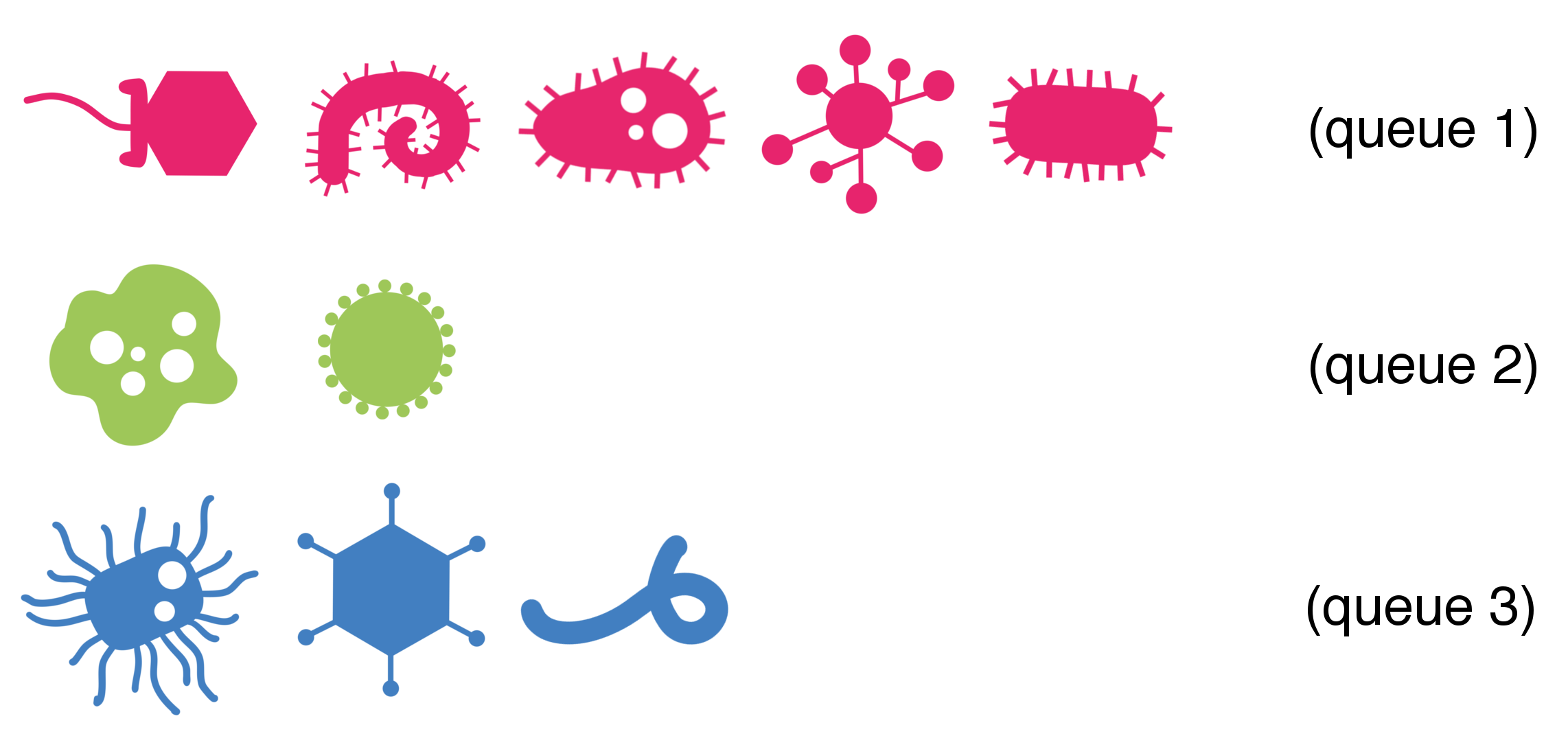Disclaimer: This is a proof-of-concept on how we might share data for genomic surveillance in the future. The code should be stable, but it is certainly not polished. Any feedback is welcome, both in terms of code and design. Pull requests welcome.
Genomic surveillance is not only limited by the speed at which genomes can be shared, but by how fast they can reach the right person or algorithm to analyse them. If you are monitoring a regional outbreak of a multiresistant Klebsiella pneumoniae and I send you some viral genomes, this will not be too useful.
DarkQ is a messaging queue for microbial genomes. It tries to solve two problems: First, how to know about interesting genomes having been sequenced elsewhere, without having to download these genomes first. And second, how to retrieve the original genomes easily once we observe something interesting.
With DarkQ, publishers (P) send (infectious) messages and consumers (C) subscribe to a filtered subset, depending on their preferences as expressed by a set of tags (see below). Say I publish all the stuff we sequence in my lab during the month, amongst other things some Klebsiella. Now you subscribe to the Klebsiella queue, or even more general to all Enterobacterales from Germany, and you filter the messages for genomes that are similar to the isolates in your current outbreak. You might discover that some of my isolates are from the same lineage as your outbreak isolates. You quickly and automatically obtain the original genome sequences, analyse them in detail, and indeed, our houses are part of the same outbreak. Now you can contact me and we can take collective action to limit the spread of this strain.
DarkQ relies on two main components, a message queue and a file sharing protocol.
Messages are MinHash signatures of the underlying genomes -- think lossy compression [1]. They can be wired efficiently across the message queue and you can compare the similarity of a pair of genomes through these signatures, too. DarkQ uses the sourmash implementation of MinHash [2]. If a given message passes the filters (subscription, genome similarity), it is downloaded through the second component of DarkQ, namely the Interplanetary File System (IPFS) protocol. Basically, it allows decentralized, peer-to-peer file sharing, which we think is crucial for effective genomic surveillance.
[1]: Ondov et al., 2016. “Mash: Fast Genome and Metagenome Distance Estimation Using MinHash.” Genome Biology 17 (1): 132.
[2]: Pierce et al., 2019. “Large-Scale Sequence Comparisons with sourmash.” F1000Research 8 (July): 1006.
# DarkQ has a couple of needs
conda create -n darkq -y python=3.7 && conda activate darkq
conda install -y -c bioconda sourmash nextflow
conda install -y -c conda-forge geocoder osfclient
# IPFS is a peer-to-peer file sharing protocol
# https://docs.ipfs.io/guides/guides/install/
# for example on linux do
wget -O go-ipfs.tar.gz https://github.com/ipfs/go-ipfs/releases/download/v0.6.0/go-ipfs_v0.6.0_linux-amd64.tar.gz
tar xvfz go-ipfs.tar.gz
cd go-ipfs
# the next command might need sudo permission
./install.sh
ipfs init
# RabbitMQ is used to publish and subscribe to messages
# https://www.rabbitmq.com/download.html
conda install -y -c conda-forge rabbitmq-server pikagit clone https://github.com/phiweger/darkq && cd darkq
# We need a taxonomy database to assign genomes to queues
osf -p wxf9z fetch \
release89/gtdb-release89-k31.lca.json.gz \
databases/gtdb-release89-k31.lca.json.gz
# Thanks Titus -- http://ivory.idyll.org/blog/2019-sourmash-lca-db-gtdb.html
# Create a custom database, which will filter the messages for similar genomes
sourmash compute -k31 --scale 1000 data/filter/*
sourmash index databases/filter *.sig && rm *.sig
# Start message queue server (to send via localhost)
rabbitmq-server &
# Start IPFS daemon
ipfs daemon &
# Start sending/ receiving infectious messages
mkdir -p data/send
nextflow run main.nf Now pull some genomes from the data/test folder into data/send and see how they turn up in data/receive. After copying all genomes from data/test to data/send you should find three genomes in data/receive -- while we sent E. coli, Klebsiella, Prochlorococcus and Enterococcus over the message queue, and our subscription made us receive them all, our genome similarity filter passed only Enterococcus to the data/receive folder. Let's turn this filter off. Put all genomes from data/send back into data/test, clear data/receive, then run:
nextflow run main.nf --filter false
# Now draw the files as before, and all genomes should passIn this example, you only shared data with yourself. To start sharing with your friends and colleagues, connect to the queue we provide:
URL=amqp://ubugbkyk:GgNs09Y0fnCTTFgEFaBnowTOD-ZFYm3v@swan.rmq.cloudamqp.com/ubugbkyk
nextflow run main.nf --url $URLMore settings, such as sketch size and user name, can be found in the nextflow.config file.
DarkQ allows you to subscribe to an arbitrary number of queues via so called "routing keys". Each routing key is unique and has five properties:
- name of sender (e.g. "phiweger")
- country code (e.g. DE)
- taxon status ("found" or "mystery")
- taxon level (either one of superkingdom, phylum, class, order, family, genus, species, strain)
- taxon name at that level (e.g. "Klebsiella" for genus) -- these are adapted from and must conform to the GTDB r89
These queues are declared in tags.csv, where empty fields mean "all". For example, let's subscribe to three queues:
- all genomes from the Prochlorococcus genus
- all genomes sent by "user1" belonging to Klebsiella pneumoniae
- all genomes sent from Germany with an unknown taxonomy
name,country,status,level,taxon
,,,genus,Prochlorococcus
user1,,,species,Klebsiella pneumoniae
,DE,mystery,,
For published messages, these tags are automatically generated. Only the receiver needs to explicitly state the desired message tags. Routing keys act as filters to the messages received over the queue. DarkQ offers a second filter, that allows similarity-based genome filtering. This filter consists of a Sequence Bloom Tree (SBT) of MinHash signatures as generated using sourmash index (see above). It is declared in the nextflow.config.


